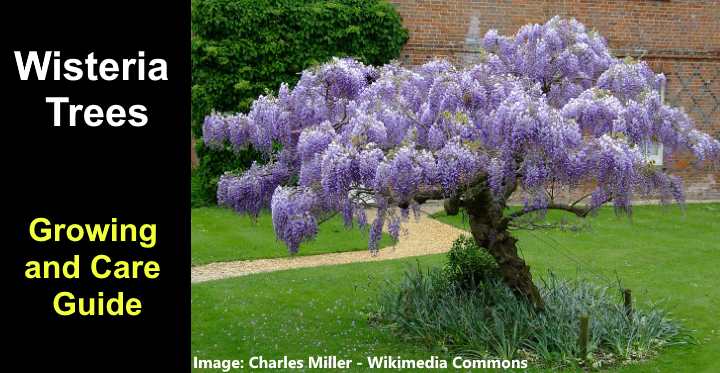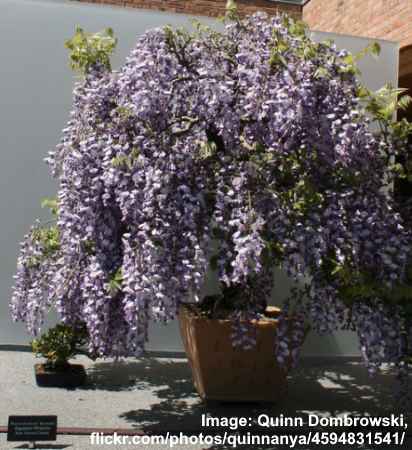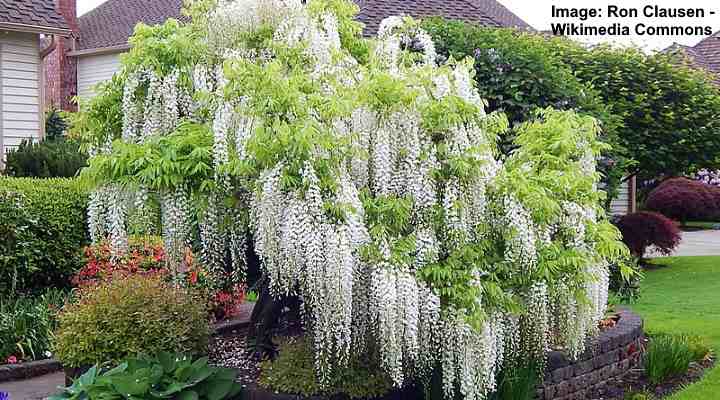Wisteria Trees (Including Blue Chinese Wisteria Tree) – Pictures and Care

The wisteria tree is a beautiful flowering plant, famed for its spectacular dangling streaming clusters of blue-purple flowers. Although wisteria is typically grown as a vining plant, you can also grow it as a single-stemmed tree. The stunning tree with its robust trunk, gnarled branches, and spreading canopy makes for a magnificent specimen tree in your garden landscape.
This article is a guide to the wisteria tree and how to care for it. You will also learn how to train a wisteria vine into a small decorative flowering tree.
What is Wisteria Tree

Wisteria tree
Wisteria tree is a woody twining wisteria vine that is trained to grow as a small tree. With the proper care, a wisteria tree can grow 6 to 10 ft. (1.8 – 3 m) tall and wide. The ornamental flowering wisteria tree is in the genus Wisteria and the legume family Fabaceae.
When in full bloom, the bare branches of the wisteria tree are adorned with masses of draping blue-purple flower clusters measuring 12” to 18” (30 – 45 cm) long. Each wisteria tree flower raceme consists of many pea-sized light blue or purple-blue fragrant flowers.
Wisteria trees bloom with purple flowers from early to mid-spring for three to four weeks. The Chinese wisteria trees bloom before foliage appears, and American wisteria trees bloom after leaves appear.
Wisteria is a fast-growing small flowering tree suitable for small to large landscapes. Growing in full sun and getting plenty of water, wisteria can grow between 3 and 5 ft. (1 – 1.5 m) per year. However, it can take three to five years before the ornamental tree begins to bloom.
Wisteria tree root system can be invasive, so it’s best to plant the decorative tree away from native shrubs and trees. Due to its aggressive root system, it’s also a good idea to grow wisteria trees away from buildings, sidewalks, or walls. Pictures of wisteria tree roots in the ground show the root system can be as large as its canopy.
Wisteria trees are cold-hardy trees that thrive in USDA zones 5 through 9.
The ornamental landscape wisteria tree performs best in full sun, getting at least six hours of sunlight daily. The tree will tolerate some shade; however, it may not bloom as abundantly.
Blue Chinese Wisteria Tree (Wisteria sinensis)

Blue Chinese wisteria tree
The blue Chinese wisteria tree is a non-native cultivar that grows as a single stem accent tree. The blue wisteria has a rounded spreading canopy, and its abundant blooms are lavender, blue, and purple. The dangling foot-long (30 cm) flower clusters emerge on bare branches and blossom for several weeks from mid-spring.
The fast-growing blue Chinese wisteria tree matures at 10 to 15 ft. (3 – 4.5 m) tall. The dwarf tree has dense green foliage throughout summer before turning golden yellow in the fall. Additionally, the ornamental tree adapts well to various soil types.
The blue Chinese wisteria has many uses in the landscape. The stunning tree works well as a specimen or lawn tree. You can also plant the flowering dwarf tree in a container, place it on a patio, or brighten up a container garden.

Potted wisteria plant
White Wisteria Tree

White wisteria tree
There are two varieties of white wisteria trees: Wisteria sinensis ‘Jako’ and Wisteria floribunda ‘Alba.’ These spectacular white wisteria trees bloom with cascading clusters of white racemes measuring up to 24” (60 cm) long. The white floral displays persist on the tree for several weeks, followed by long attractive bean pods.
Like the blue wisteria tree, the white wisteria thrives in full sun to partial shade. You can grow the drought-tolerant tree as a specimen tree or in a container. As this is a vining plant, you will need to prune it and support its growth as a tree.
Wisteria Tree Flowers

Wisteria flowers
Flowers growing on the wisteria tree are large clusters of beautiful lilac, blue, pink or white blossoms. The long dangling racemes can measure between 6” and 24” (15 – 60 cm) long, depending on the cultivar. When blooming in mid-spring, the magnificent flowers give off a sweet aroma.
The wisteria flower clusters consist of many individual lilac, white, blue, or pink peas-sized blossoms. Flowering usually starts from the base, and the flowering clusters eventually become completely purple, blue, pink, or white. The dramatic floral displays of wisteria trees or vines are breathtaking every spring and summer.
How to Get a Wisteria Tree to Flower
Wisteria is a high-maintenance flowering tree that requires regular pruning to flower. Therefore, it’s necessary to heavily prune a wisteria every summer and winter to promote vigorous blooming in springtime. Ideally, the wisteria tree needs short flowering stems for masses of spring flowers to cover the tree’s crown.
Depending on your climate, Wisteria flowers appear on new growth each year in late spring or early summer.
About two or three months after flowering, prune back new growth to leave about five large buds on each new stem. You should also remove any trailing stems or stems that affect the tree’s overall appearance.
Then in late winter, prune off branches that rub against each other and cut back the same stems as you pruned in summer. The goal is to have two or three swollen flower buds per new-growth stem.
If you get the pruning right, you should enjoy masses of fragrant flowers a few weeks after pruning when the wisteria blooms again in late spring.
Is Wisteria Tree Invasive?
Chinese and Japanese wisteria trees have invasive roots that can choke native plants in your garden. In addition, non-native twining wisteria vines spread rapidly, sometimes up to 10 ft. (3 m) per season. The purple vining plant can rapidly twine around shrubs and trees, blocking sunlight and killing them.
Another issue with non-native Chinese wisteria is its tough root system. Once established, the roots can be difficult to remove altogether. However, if you don’t get rid of them entirely, the wisteria vines can grow again.
Because regular pruning controls a wisteria tree’s growth, ornamental trees tend to be less invasive. For example, there are no twining vines that take over arbors, pergolas, or fences. Instead, you have a single-stemmed tree with a spreading canopy of beautiful flowers and lush foliage.
Chinese Wisteria vs. American Wisteria
The American wisteria (Wisteria frutescens) grows more slowly and is less aggressive than the Chinese wisteria plant (Wisteria sinensis). As a result, American wisteria tree flowers tend to be more compact and rounder than Chinese wisteria blossoms. In addition, they are not as fragrant.
And unlike Chinese wisterias, which flower while the tree is still leafless, the North American varieties bloom after they have leafed out.
Dwarf Wisteria Tree for Small Gardens
Dwarf wisteria tree cultivars are ideal for planting in small gardens or containers. Growing in a container will also prevent the fast-growing deciduous plant from taking over other plants. Typically dwarf wisterias grow between 10 and 20 ft. (3 – 6 m) tall.
The best way to grow a dwarf wisteria tree in a small garden landscape is to buy a single-stemmed nursery plant. Plant the rooted tree in the soil and place a 5-foot (1.5 m) support stout 3” (7.5 cm) away from the root. Tie cloth strips to the stem to support the immature tree.
Once the tree has grown around 5 ft. (1.5 m), chop the top of the main stem, just above a growth node. This will help the crown to spread out and develop a rounded canopy. Regular maintenance should involve pruning side shoots and removing dead or misplaced branches twice a year.
When to Plant Wisteria Tree
Early spring or late fall is the best time to plant a wisteria tree. Planting a flowering tree in the ground while it’s dormant allows the roots to get established before vigorous growth. If you are planting a container-grown wisteria, you can transfer it to the ground at any time of the year.
Where to Plant Wisteria Tree
Plant a wisteria tree in fertile, well-drained soil. Wisterias need full sun, so the best planting location is a south- or west-facing part of your garden. A wisteria tree will grow in partial shade, but flowering will be reduced, and the foliage may be susceptible to foliar fungal diseases.
Where you decide to plant a wisteria tree also depends on your landscaping goals. For example, this breathtaking flowering tree can anchor the corner of your yard. Or you could plant three wisteria trees in a group for a spectacular spring floral show. The dwarf tree is also suitable for growing in a flower bed.
How to Plant Wisteria Tree
After choosing where to plant a wisteria tree, you should prepare the ground for planting. First, dig a hole the same depth as the root ball and three times wide. Set the plant in the ground, so the point where the stem meets the roots is 1” (2.5 cm) below the soil surface.
Next, backfill the hole with native soil amended with compost, pressing down as you go to remove air pockets. Then, firm the soil around the central stem. Finally, give the root area a thorough soaking to help the roots get established and remove any remaining air pockets.
To support your tree Wisteria, push a wooden stake into the ground 6” to 12” (15 – 30 cm) deep and 0.5” (2.5 cm) away from its trunk. Secure the wisteria tree using cloth ties every 8” (20 cm) up the trunk. Then add a 2” to 3” (7.5 cm) layer of mulch around the root area to lock in moisture and stop weeds from growing.
Wisteria Tree Care Guide
Growing wisteria trees can be easy if you know how to take care of them properly. However, growing a wisteria tree in your garden requires regular maintenance and appropriate watering. But, if you get these things right, you can enjoy abundant lilac blooms every year in your front or backyard.
How to Water Wisteria Tree
A wisteria tree thrives in moist, well-drained, fertile soil and is relatively drought-tolerant once established. Water wisteria trees deeply about twice a week with a hose for the first two to three months after planting to provide the equivalent of 1” (2.5 cm) of water. After that, water the ground enough to keep it moist.
You can protect the roots of your plants, control weeds, and maintain moisture in the ground by adding about 2 inches (5 cm) of mulch.
Wisteria Tree Fertilization
A wisteria tree has few fertilizing requirements and only needs additional nutrients if the ground is especially poor or sandy. However, excessive fertilizer or nitrogen-rich fertilizer can inhibit blooming and weaken the plant’s growth. You can fertilize a wisteria tree once every spring with a 5-10-5 or 0-20-0 tree fertilizer.
How to Prune Wisteria Tree
Appropriate pruning is critical to encourage blooming and develop an attractive crown on the wisteria tree. During the first few years, remove lateral shoots below the branching crown. Once the tree starts flowering, it’s vital to prune it hard in early fall.
To prune a wisteria tree, you should cut back the current season’s growth to leave five or six large buds on the stem. Then, you can safely remove any out-of-place branches. The hard pruning encourages more flower buds to form and bloom the following season.
Propagating Wisteria Tree
Propagating a wisteria tree is best done in the spring or early summer when the plants grow vigorously. To propagate a wisteria tree, cut off new-growth stems about 6” (15 cm) long. Next, remove the lower leaves and dip the cut end in rooting hormone.
To root a wisteria cutting, place the cut end in a pot filled with a mixture of moist peat moss and perlite. Cover and seal with a plastic bag and put the cutting in a warm place, out of direct sunlight. Keep the soil moist by misting it if necessary. After four to six weeks, the roots should appear.
When you see new growth, you can remove the plastic bag and continue to grow the new wisteria tree in the pot. If you live in a temperate climate, transfer the cutting to a larger pot after two to three months. Then you can plant the new tree in the ground the following spring.
Pests Affecting Wisteria Tree Growth
Wisteria trees are relatively resistant to pest infestations. Some common garden bugs like aphids, scale insects, and mealybugs can affect the flowering trees. However, these pesky insects rarely do any lasting damage to wisteria trees or Chinese wisteria trees. One pest that can do damage to wisteria plants is the wisteria borer.
The wisteria borer is a tiny beetle that bores into the woody stems of wisteria vines and trees. The plant-eating insects spend most of their lives in the limbs and can kill wisteria plants if they disrupt water and nutrient transport tissues.
The best way to prevent wisteria borer damage is to keep your decorative tree healthy and well-nourished. Borers tend to seek out stressed or unhealthy plants to infest.
Signs of borer activity are perfectly round small holes in wisteria tree trunks or branches. If you notice these, use Bacillus thuringiensis or Spinosad to get rid of the destructive bugs naturally. With a small infestation, you can use a length of thin wire to skewer the larvae in spring when they begin to hatch.
Diseases Affecting Wisteria Tree Growth
Healthy wisteria trees are relatively disease-resistant plants. However, some foliar fungal diseases can affect the lance-shaped, pinnately compound leaves. For example, powdery mildew and leaf spot can affect the appearance of your beautiful wisteria tree.
Powdery mildew on a wisteria tree looks like a white waxy coating on the leaves. This harmless fungal disease is typically caused by a lack of air circulation and cool temperatures. However, watering the tree foliage can also encourage powdery mildew.
To prevent powdery mildew from affecting your tree’s appearance, you should regularly prune the branches to increase airflow between the leaves. Also, it’s best to always water the roots and never the leaves.
Leaf spot is a fungal disease that looks like a fuzzy yellow or brown spot on the tree’s foliage. Fungal leaf infections are generally not serious and are preventable by ensuring that your plant has sufficient airflow. If the condition is widespread, prune away infected areas before spraying remaining leaves with neem oil.
Related articles:
